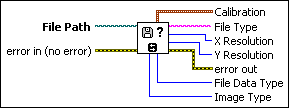IMAQ GetFileInfo VI
Owning Palette: FilesInstalled With: NI Vision Development ModuleObtains information regarding the contents of the file. This information is supplied for standard file formats only: BMP, TIFF, JPEG, JPEG2000, PNG, or AIPD.

 |
File Path is the complete pathname—including drive, directory, and filename—for the file to be examined. This path can be supplied by either the user or the File Dialog VI from LabVIEW. |
||||||||||||||||||||||||||||||||
 |
error in (no error) describes the error status before this VI or function runs. The default is no error. If an error occurred before this VI or function runs, the VI or function passes the error in value to error out. This VI or function runs normally only if no error occurred before this VI or function runs. If an error occurs while this VI or function runs, it runs normally and sets its own error status in error out. Use the Simple Error Handler or General Error Handler VIs to display the description of the error code. Use error in and error out to check errors and to specify execution order by wiring error out from one node to error in of the next node.
|
||||||||||||||||||||||||||||||||
 |
Calibration is a cluster containing the following elements:
|
||||||||||||||||||||||||||||||||
 |
File Type indicates the file type that is read: BMP, TIFF, JPEG, JPEG2000, PNG, or AIPD (internal file format). |
||||||||||||||||||||||||||||||||
 |
X Resolution specifies the horizontal resolution of the image. |
||||||||||||||||||||||||||||||||
 |
Y Resolution specifies the vertical resolution of the image. |
||||||||||||||||||||||||||||||||
 |
error out contains error information. If error in indicates that an error occurred before this VI or function ran, error out contains the same error information. Otherwise, it describes the error status that this VI or function produces. Right-click the error out indicator on the front panel and select Explain Error from the shortcut menu for more information about the error.
|
||||||||||||||||||||||||||||||||
 |
File Data Type indicates the pixel size defined in the header of the file. |
||||||||||||||||||||||||||||||||
 |
Image Type specifies the type of image that best fits the File Data Type of the file. This output can have the following values:
|





